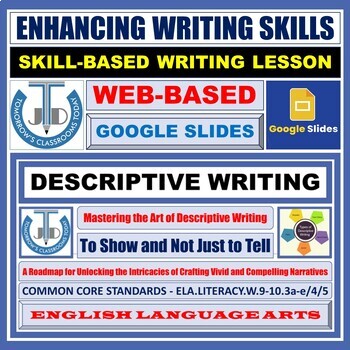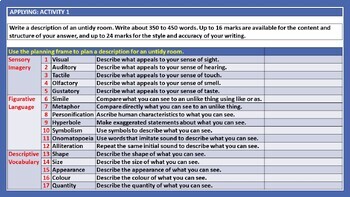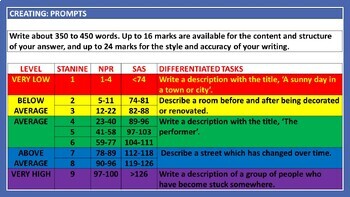Mastering the Art of Descriptive Writing - Google Slides
- Google Slides™
- Internet Activities

Also included in
- This immersive bundle is a comprehensive guide tailored to empower both students and educators in the art of descriptive writing. This tutorial is a roadmap for unlocking the intricacies of crafting vivid and compelling narratives to show and not just to tell. This resource is aligned with Bloom’s TPrice $9.80Original Price $14.00Save $4.20
Description
An immersive Google Slides is a comprehensive guide tailored to empower both students and educators on the art of descriptive writing. This tutorial is a roadmap for unlocking the intricacies of crafting vivid and compelling narratives to show and not just to tell. This resource is aligned with Bloom’s Taxonomy and the Common Core Standards for Writing.
This resource includes:
REMEMBERING
Beginning with the foundational stage of Remembering, participants will revisit the essential components of descriptive writing, cultivating an awareness of sensory imagery, figurative language, descriptive language, organised structure, sentence structure, transitions, sentence starters, tone, mood and language register. The focus here is not just on recognition but on understanding the profound impact these components have on the reader, with a keen eye to spot the nuanced effects of sentence structure in their descriptive writing.
UNDERSTANDING
Moving forward into the realm of Understanding, participants will delve into the why behind the techniques. They will articulate the purpose of sensory imagery across visual, auditory, tactile, olfactory and gustatory dimensions. The significance of figurative language, including simile, metaphor, personification, hyperbole, symbolism, onomatopoeia, and alliteration, will be illuminated. Participants will exemplify the effects of descriptive language, exploring the nuances of shape, size, appearance, colour and quantity adjectives. Students will also test themselves to demonstrate their understanding of the descriptive techniques.
APPLYING
Transitioning to the Applying stage, participants will be guided to infuse descriptive writing techniques into specific contexts. They will use the word bank—adjectives specific to senses—and the other adjective types to plan a description of a given topic. They will learn to weave complex and engaging content, utilising evocative language, literary devices, and descriptive visuals. The emphasis here is on organising and structuring ideas and opinions for deliberate effect, aligning with Writing Standard 2 (W2).
ANALYSING
As we progress to the Analysing stage, participants will develop a discerning eye to identify strengths and weaknesses in descriptive writing. They will dissect descriptive essays, evaluating the clarity and development of ideas, the evocative nature of images, and the overall convincing picture painted by the author. Effective articulation of personal experiences, thoughts, feelings, and imagination will be scrutinised, along with a close inspection of organisational structures aligning with Writing Standards 1 and 2 (W1, W2).
EVALUATING
Now, at the pinnacle of the tutorial, the Evaluating stage beckons participants to assess the effectiveness of descriptive writing in achieving its purpose. They will critically evaluate the use of precise vocabulary, varied sentence structures, and the consistency and appropriateness of language register, aligning with Writing Standards 3 and 4 (W3, W4). Constructive peer feedback will be emphasised, fostering a collaborative learning environment.
CREATING
Finally, in the Creating stage, participants will apply their acquired knowledge to craft a descriptive piece that meets specified criteria. Mastery will be demonstrated through the adept use of a rich vocabulary, diverse sentence structures, a consistent language register, accurate spelling, punctuation, and grammar (aligned with Writing Standard 5, W5). For differentiated learning, tailored prompts based on individual performance in assessments will be provided. This ensures targeted support, addressing diverse learning levels, specific needs, and individual abilities.
To complete the learning journey, comprehensive rubrics will be employed to assess student outcomes, covering content and structure, style, and accuracy. Join us in this transformative exploration of descriptive writing, where words come to life and narratives flourish!
More reading and writing resources by the same author:
- Description
- Narrative Writing
- Persuasive Writing
- Argumentative Writing
- Newspaper Report
- Biography
- Information Text
- Diary Entry
- Magazine Article
- Summary Writing
- Descriptive Writing
This is what teachers say about these resources:
- PREPOSITIONS OF PLACE: 27 GOOGLE SLIDES - comment from A Social Teacher: "My students found the slides very engaging." Rating: 5/5 (extremely satisfied)
- SENTENCE KINDS BY FUNCTION: 24 GOOGLE SLIDES - Denise Hickey: "This is a great resource that is easy to use." Rating: 4/5 (very satisfied).
- IDIOMS: GOOGLE SLIDES - BASED ON BLOOM'S TAXONOMY - Marie Seaman: "Super resource!" Rating: 5/5 (extremely satisfied)
- IF- BY RUDYARD KIPLING - READING A DIDACTIC POEM - GOOGLE SLIDES - Comment from Aaron Nicholson: "This resource assisted me in teaching my scholars not just about didactic poetry but enhanced my instruction on how to analyze this particular poem." Rating: 5/5 (extremely satisfied)
Customer Tips: How to get TPT credit to use for future purchases
- Follow me HERE to get notified of updates, sales, free resources, and new products.
- Please go to your My Purchases page (you may need to LOG IN). Beside each purchase, you'll see a Provide Feedback button. Simply click it, and you will be taken to a page where you can give a quick rating and leave a short comment about the product.
- Each time you give feedback, TPT gives you feedback credits that you can use to lower the cost of your future purchases.
- I value your feedback greatly, as it helps me determine which products are most valuable for your classroom so I can create more for you.
- Look for the green star next to my store logo and click it to become a FOLLOWER. You will now receive email updates about this store. Be the first to know about my new discounts, freebies, and product launches.
Find Me Here:
- TPT Store - JOHN DSOUZA
- Pinterest - JOHN DSOUZA
- Facebook - TOMORROW’S CLASSROOM TODAY
- Instagram - JOHN421969
- Twitter - JOHN421969
- Boom Learning - JOHN DSOUZA
- YouTube - JOHN DSOUZA






